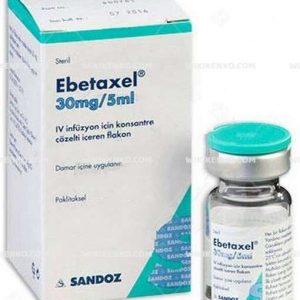Epanutin Ready Mixed Parenteral
Epanutin Ready Mixed Parenteral, a formulation of phenytoin sodium, is a highly effective anticonvulsant used for various medical purposes. Its mechanism of action involves regulating sodium ions across cell membranes, thereby stabilizing neuronal membranes and reducing seizure activity. In this article, we will explore the uses, dosage guidelines, and potential side effects of Epanutin Ready Mixed Parenteral, ensuring you have all the necessary information for informed decision-making.
| Dosage form | |
|---|---|
| Pack size | |
| Potency | 250 Mg/5Ml |
| Manufacturer | |
| Origin | |
| Generic Name (Ingredient) | Phenytoin Sodium 250 Mg |
Assuming your emergency circumstances for this product, visit Urgent Quotation page. Besides, for any pharmaceutical questions, please ask us in the comments section.
Description
Uses: Treating Epileptic Seizures and Cardiac Arrhythmias
Epanutin Ready Mixed Parenteral is primarily prescribed for two key medical conditions: generalized tonic-clonic status epilepticus and seizures occurring during neurosurgery. Moreover, it can serve as a short-term substitute for oral phenytoin in certain cases.
Additionally, Epanutin Ready Mixed Parenteral exhibits efficacy in treating cardiac arrhythmias, particularly in scenarios where initial treatment options prove ineffective, especially when the arrhythmias are induced by digitalis.
Warnings: Cardiovascular Adverse Effects
Revised Safety Precautionary Measures (Sections 4.4 and 4.8) emphasize the potential cardiovascular adverse effects of Epanutin Ready Mixed Parenteral. These effects include asystole/cardiac arrest and bradycardia, which should be considered when assessing the risks and benefits of the medication.
Dosage Guidelines: Tailored to Individual Needs
The appropriate dosage of Epanutin Ready Mixed Parenteral depends on the specific medical condition being treated. For generalized tonic-clonic status epilepticus, a loading dose of phenytoin ranging from 10mg/kg to 15mg/kg should be administered slowly through intravenous injection.
It is crucial to ensure that the injection rate does not exceed 50mg per minute. Subsequently, a maintenance dose of 100mg, administered orally or intravenously, should be given every 6 to 8 hours to sustain the therapeutic effect.
Potential Side Effects: Addressing Common Concerns
While Epanutin Ready Mixed Parenteral can be highly effective, it is important to be aware of potential side effects. Commonly observed side effects include nausea, vomiting, constipation, tremors, slurred speech, loss of balance or coordination, rash, headache, confusion, dizziness, nervousness, and sleep problems (insomnia). It is worth noting that these effects are generally temporary and may subside with continued use. However, it is crucial to consult with your healthcare provider if any concerns arise.
In rare instances, Epanutin Ready Mixed Parenteral may trigger an allergic reaction. Signs of an allergic reaction may include hives, difficulty breathing, and swelling of the face, lips, tongue, or throat. African-Americans may have a higher susceptibility to allergic reactions. Should you experience any of these symptoms, it is imperative to seek immediate medical attention to ensure appropriate management and care.
Conclusion: Ensuring Informed Medication Decisions
Epanutin Ready Mixed Parenteral, a valuable anticonvulsant and arrhythmia treatment, offers therapeutic benefits for individuals with specific medical conditions. By understanding its uses, dosage guidelines, and potential side effects, you can make informed decisions about its suitability for your healthcare needs.
As with any medication, it is important to consult your healthcare provider for personalized advice and to address any concerns or questions you may have. Your well-being and health are paramount, and together with your healthcare team, you can navigate the path towards optimal care and treatment.
1 review for Epanutin Ready Mixed Parenteral
Use the form below to report an error
Please answer the questions as thoroughly and accurately as possible. Your answers will help us better understand what kind of mistakes happen, why and where they happen, and in the end the purpose is to build a better archive to guide researchers and professionals around the world.
The information on this page is not intended to be a substitute for professional medical advice, diagnosis, or treatment. always seek the advice for your physician or another qualified health provider with any questions you may have regarding a medical condition. Always remember to
- Ask your own doctor for medical advice.
- Names, brands, and dosage may differ between countries.
- When not feeling well, or experiencing side effects always contact your own doctor.
Cyberchondria
The truth is that when we’re sick, or worried about getting sick, the internet won’t help.
According to Wikipedia, cyberchondria is a mental disorder consisting in the desire to independently make a diagnosis based on the symptoms of diseases described on Internet sites.
Why you can't look for symptoms on the Internet
If diagnoses could be made simply from a textbook or an article on a website, we would all be doctors and treat ourselves. Nothing can replace the experience and knowledge of specially trained people. As in any field, in medicine there are unscrupulous specialists, differences of opinion, inaccurate diagnoses and incorrect test results.







Natia –
4
Medical Guidance Center –
Hello Natia, this is WikiKenko,
Would you please describe more about your statement, unfortunately we don’t know what do you mean by “4”.